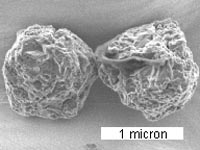| Murchison meteorite | |
|---|---|
 A Murchison meteorite specimen at the National Museum of Natural History, Washington, D.C. | |
| Type | Chondrite |
| Class | Carbonaceous chondrite |
| Group | CM2 |
| Composition | 22.13% total iron, 12% water |
| Shock stage | S1–2 |
| Country | Australia |
| Region | Victoria |
| Coordinates | 36°37′S 145°12′E / 36.617°S 145.200°E[1] |
| Observed fall | Yes |
| Fall date | 28 September 1969 |
| TKW | 100 kg (220 lb) |
 Pair of grains from the Murchison meteorite | |
The Murchison meteorite is a meteorite that fell in Australia in 1969 near Murchison, Victoria. It belongs to the carbonaceous chondrite class, a group of meteorites rich in organic compounds. Due to its mass (over 100 kg or 220 lb) and the fact that it was an observed fall, the Murchison meteorite is one of the most studied of all meteorites.[2]
In January 2020, cosmochemists reported that the oldest material found on Earth to date are the silicon carbide particles from the Murchison meteorite, which have been determined to be 7 billion years old, about 2.5 billion years older than the 4.54-billion-year age of the Earth and the Solar System.[a] The published study noted that "dust lifetime estimates mainly rely on sophisticated theoretical models. These models, however, focus on the more common small dust grains and are based on assumptions with large uncertainties."[3]
- ^ Meteoritical Bulletin Database: Murchison
- ^ Botta, Oliver; Bada, Jeffrey L. (2002). "Extraterrestrial Organic Compounds in Meteorites". Surveys in Geophysics. 23 (5): 414. doi:10.1023/A:1020139302770. S2CID 93938395.
- ^ Heck, Philipp R.; Greer, Jennika; Kööp, Levke; Trappitsch, Reto; Gyngard, Frank; Busemann, Henner; Maden, Colin; Ávila, Janaína N.; Davis, Andrew M.; Wieler, Rainer (13 January 2020). "Lifetimes of interstellar dust from cosmic ray exposure ages of presolar silicon carbide". Proceedings of the National Academy of Sciences. 117 (4): 1884–1889. Bibcode:2020PNAS..117.1884H. doi:10.1073/pnas.1904573117. PMC 6995017. PMID 31932423.
Cite error: There are <ref group=lower-alpha> tags or {{efn}} templates on this page, but the references will not show without a {{reflist|group=lower-alpha}} template or {{notelist}} template (see the help page).